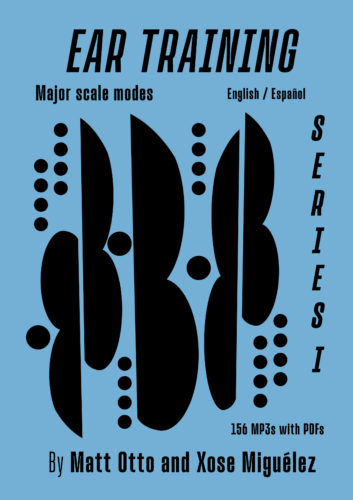Saxophonist Xose Miguelez and I put together an ear training series that uses what I like to call “passive learning”. The series includes 156 mp3s and pdfs to sing along with and train your ear focusing on the modes of the major scale. Each mode in each key includes exercises that are harmonic, melodic and intervallic and will vastly improve your ear and your understanding of the modes and sounds of the major scale. Below I’ve included a shortened version of the introduction to help clarify the concept of passive learning and how to use the material contained in the ear training series.

.
This ear training method is what I like to call “passive ear training”. Much like the way we learned to speak, the method incorporates listening and copying over and over. What I recommend is focusing on just one key per month over 12 months. This will give you a deep and strong understanding of each of the modes of the major scale in every key. Listening and singing along will be all that is necessary at first. Sing one track over and over until, after stopping the track, you can sing the whole exercise well and in tune accapella. This singing in tune will be proof that you have truly learned to hear the material. If you move through the series this well, it will have a compounding effect and fundamentally change your ear and understanding of modes. After going through all 12 keys begin intellectualizing and thinking about the modes and the numbers or relationship to the major scale. This may include playing the material on your instrument but not necessarily. Just understand each note of the scale or melody in relationship to the chord and root it is found within. Thinking or knowing, “this is the b9, this is the #11, this is a Bb-7 chord”, etc…This ear-training course is meant to be primarily a strong introduction to the modes of the major scale using melody as the entry point. By singing melodic ideas that imply each mode in a clear way you will begin to hear the detail of each mode and its harmonic and melodic significance. The exception to the clear melodic outline of each mode would be the more advanced shapes derived from diatonic cycle motions (3, 6, 4, and 5). These cycles create more of modal or general sound in that they are not always harmonically specific with chord tones falling strictly on strong beats. This is, however, an excellent way to begin hearing in a more general sense after developing a strong grasp of the detailed sound of each mode.Matt Otto/Xose Miguelez
To support mattotto.org please visit the store: https://mattotto.e-junkie.com/







